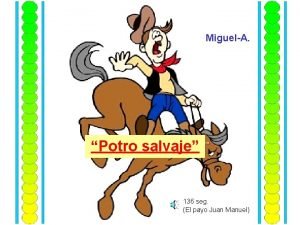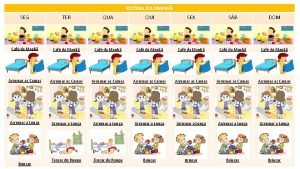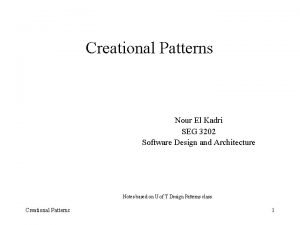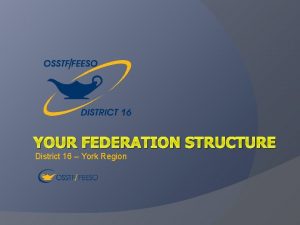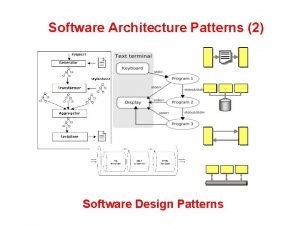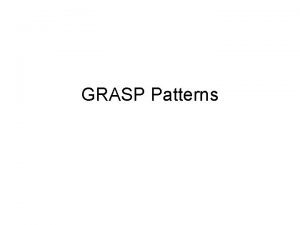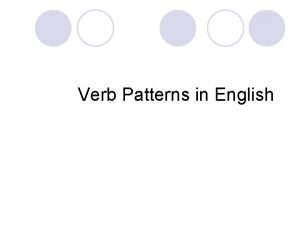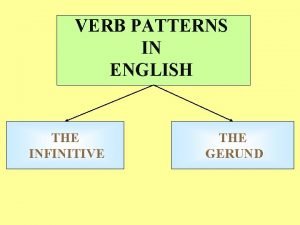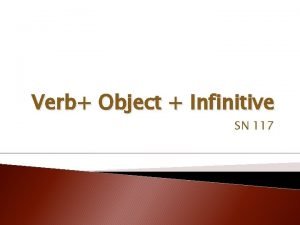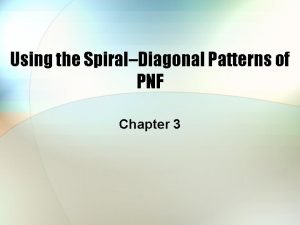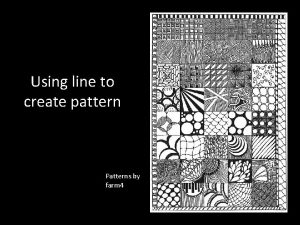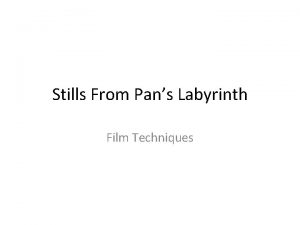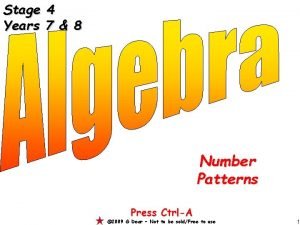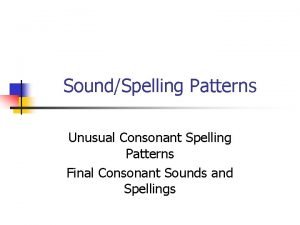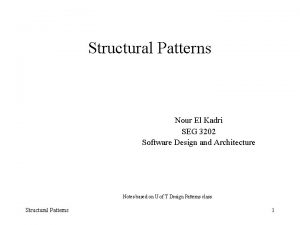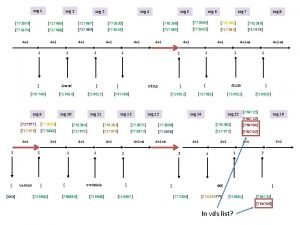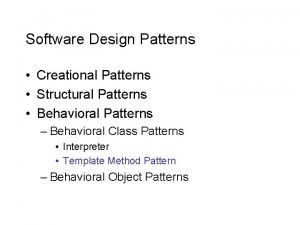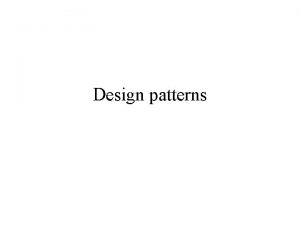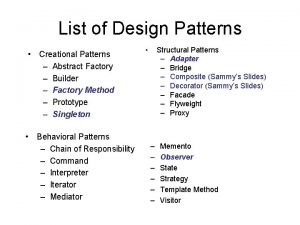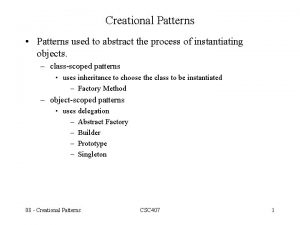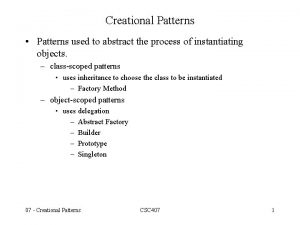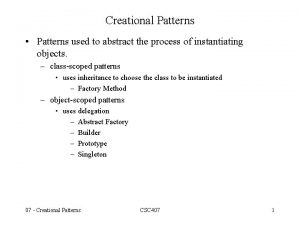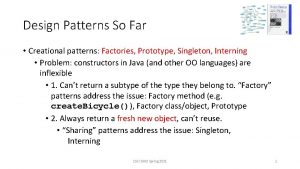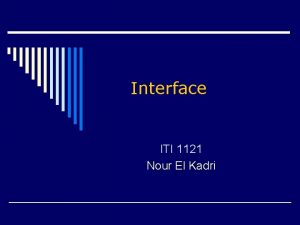Creational Patterns Nour El Kadri SEG 3202 Software






![Creating Mazes public class Maze. Game { public static void main(String args[]) { Maze Creating Mazes public class Maze. Game { public static void main(String args[]) { Maze](https://slidetodoc.com/presentation_image_h/8b936767b9c14d0b776024839b65c4a9/image-7.jpg)













![Sample Code public class Maze. Game { public static void main(String args[]) { Maze Sample Code public class Maze. Game { public static void main(String args[]) { Maze](https://slidetodoc.com/presentation_image_h/8b936767b9c14d0b776024839b65c4a9/image-21.jpg)


![Sample Code public static void main(String args[]) { Maze m = new Enchanted. Maze. Sample Code public static void main(String args[]) { Maze m = new Enchanted. Maze.](https://slidetodoc.com/presentation_image_h/8b936767b9c14d0b776024839b65c4a9/image-24.jpg)













![Sample Code public class Maze. Game { public static void main(String args[]) { Maze Sample Code public class Maze. Game { public static void main(String args[]) { Maze](https://slidetodoc.com/presentation_image_h/8b936767b9c14d0b776024839b65c4a9/image-38.jpg)









![Prototype-based Implementation public class Main { public static void main(String args[]) { Concrete. Factory Prototype-based Implementation public class Main { public static void main(String args[]) { Concrete. Factory](https://slidetodoc.com/presentation_image_h/8b936767b9c14d0b776024839b65c4a9/image-48.jpg)

![Class Registration Implementation public class Main { public static void main(String args[]) throws Exception Class Registration Implementation public class Main { public static void main(String args[]) throws Exception](https://slidetodoc.com/presentation_image_h/8b936767b9c14d0b776024839b65c4a9/image-50.jpg)









![Sample Code public static void main(String args[]) { Maze. Factory mf = new Maze. Sample Code public static void main(String args[]) { Maze. Factory mf = new Maze.](https://slidetodoc.com/presentation_image_h/8b936767b9c14d0b776024839b65c4a9/image-60.jpg)























![Sample Code public class Maze. Game { public static void main(String args[]) { Maze. Sample Code public class Maze. Game { public static void main(String args[]) { Maze.](https://slidetodoc.com/presentation_image_h/8b936767b9c14d0b776024839b65c4a9/image-84.jpg)





- Slides: 89

Creational Patterns Nour El Kadri SEG 3202 Software Design and Architecture Notes based on U of T Design Patterns class Creational Patterns 1

Creational Patterns • Patterns used to abstract the process of instantiating objects. – class-scoped patterns • uses inheritance to choose the class to be instantiated – Factory Method – object-scoped patterns • uses delegation – Abstract Factory – Builder – Prototype – Singleton Creational Patterns 2

Importance • Becomes important as emphasis moves towards dynamically composing smaller objects to achieve complex behaviours. – need more than just instantiating a class – need consistent ways of creating related objects. Creational Patterns 3

Recurring Themes • Hide the secret about which concrete classes the system uses. • Hide the secret about how instances are created and associated. • Gives flexibility in – – what gets created who creates it how it gets created when it gets created Creational Patterns 4

Running Example • Building a maze for a computer game. • A Maze is a set of Rooms. • A Room knows its neighbours. – another room – a wall – a door Creational Patterns 5

Maze Example Creational Patterns 6
![Creating Mazes public class Maze Game public static void mainString args Maze Creating Mazes public class Maze. Game { public static void main(String args[]) { Maze](https://slidetodoc.com/presentation_image_h/8b936767b9c14d0b776024839b65c4a9/image-7.jpg)
Creating Mazes public class Maze. Game { public static void main(String args[]) { Maze m = new Maze. Game(). create. Maze(); } public Maze Room r 1 Room r 2 Door d create. Maze() { = new Room(1); = new Room(2); = new Door(r 1, r 2); r 1. set. Side(Direction. North, new Wall()); r 1. set. Side(Direction. East, d); r 1. set. Side(Direction. West, new Wall()); r 1. set. Side(Direction. South, new Wall()); r 2. set. Side(Direction. North, new Wall()); r 2. set. Side(Direction. West, d); r 2. set. Side(Direction. East, new Wall()); r 2. set. Side(Direction. South, new Wall()); } } Maze m = new Maze(); m. add. Room(r 1); m. add. Room(r 2); return m; Creational Patterns d r 1 r 2 7

Maze Classes public abstract class Map. Site { public abstract void enter(); } Map. Site enter() public class Wall extends Map. Site { public void enter() { } } Wall enter() Creational Patterns 8

Maze Classes public class Door extends Map. Site { Door(Room s 1, Room s 2) { side 1 = s 1; side 2 = s 2; } Map. Site enter() public void enter() { } public Room other. Side. From(Room r) { if( r == side 1 ) return side 2; else if( r == side 2 ) return side 1; else return null; } Door side 1, side 2 [0. . 4] enter() other. Side. From(Room): Room public void set. Open(boolean b) { open = b; } public boolean get. Open() { return open; } } private Room side 1; private Room side 2; boolean open; Creational Patterns open: boolean 2 Room 9

Maze Classes public class Direction { public final static public final static } Creational Patterns int int First = 0; North = First; South = North+1; East = South+1; West = East+1; Last = West; Num = Last-First+1; 10

Maze Classes public class Room extends Map. Site { public Room(int r) { room_no = r; } public void enter() { } Map. Site enter() 4 public void set. Side(int direction, Map. Site ms) { side[direction] = ms; } public Map. Site get. Side(int direction) { return side[direction]; } Room enter() public void set. Room_no(int r) { room_no = r; } public int get. Room_no() { return room_no; } } private int room_no; private Map. Site[] side = new Map. Site[Direction. Num]; Creational Patterns 11

Maze Classes import java. util. Vector; public class Maze { public void add. Room(Room r) { rooms. add. Element(r); } public Room get. Room(int r) { return (Room)rooms. element. At(r); } Maze * Room public int num. Rooms() { return rooms. size(); } private Vector rooms = new Vector(); } Creational Patterns 12

Maze Creation public Maze Room r 1 Room r 2 Door d create. Maze() { = new Room(1); = new Room(2); = new Door(r 1, r 2); r 1. set. Side(Direction. North, new Wall()); r 1. set. Side(Direction. East, d); r 1. set. Side(Direction. West, new Wall()); r 1. set. Side(Direction. South, new Wall()); r 2. set. Side(Direction. North, new Wall()); r 2. set. Side(Direction. East, d); r 2. set. Side(Direction. West, new Wall()); r 2. set. Side(Direction. South, new Wall()); } Maze m = new Maze(); m. add. Room(r 1); m. add. Room(r 2); return m; Creational Patterns 13

Maze Creation • Fairly complex member just to create a maze with two rooms. • Obvious simplification: – Room() could initialize sides with 4 new Wall() – That just moves the code elsewhere. • Problem lies elsewhere: inflexibility – Hard-codes the maze creation – Changing the layout can only be done by re-writing, or overriding and re-writing. Creational Patterns 14

Creational Patterns Benefits • Will make the maze more flexible. – easy to change the components of a maze – e. g. , Door. Needing. Spell, Enchanted. Room • How can you change create. Maze() so that it creates mazes with these different kind of classes? • Biggest obstacle is hard-coding of class names. Creational Patterns 15

Creational Patterns • If create. Maze() calls virtuals to construct components – Factory Method • If create. Maze() is passed a parameter object to create rooms, walls, … – Abstract Factory • If create. Maze() is passed a parameter object to create and connect-up mazes – Builder • If create. Maze is parameterized with various prototypical rooms, doors, walls, … which it copies and then adds to the maze – Prototype • Need to ensure there is only one maze per game, and everybody can access it, and can extend or replace the maze without touching other code. – Singleton Creational Patterns 16

Factory Method • Define an interface for creating an object, but let subclasses decide which class to instantiate. • a. k. a. Virtual Constructor • e. g. , app framework factory method Creational Patterns 17

Applicability • Use when: – A class can’t anticipate the kind of objects to create. – Hide the secret of which helper subclass is the current delegate. Creational Patterns 18

Structure • Product – defines the interface of objects the factory method creates • Concrete. Product – implements the Product interface Creational Patterns 19

Structure • Creator – declares the factory method which return a Product type. – [define a default implementation] – [call the factory method itself] • Concrete. Creator – overrides the factory method to return an instance of a Concrete. Product Creational Patterns 20
![Sample Code public class Maze Game public static void mainString args Maze Sample Code public class Maze. Game { public static void main(String args[]) { Maze](https://slidetodoc.com/presentation_image_h/8b936767b9c14d0b776024839b65c4a9/image-21.jpg)
Sample Code public class Maze. Game { public static void main(String args[]) { Maze m = new Maze. Game(). create. Maze(); } private Maze Wall Room Door make. Maze() { return new Maze(); } make. Wall() { return new Wall(); } make. Room(int r) { return new Room(r); } make. Door(Room r 1, Room r 2) { return new Door(r 1, r 2); } public Maze create. Maze() { … } } Creational Patterns 21

Sample Code public Maze create. Maze() { Room r 1 = make. Room(1); Room r 2 = make. Room(2); Door d = make. Door(r 1, r 2); r 1. set. Side(Direction. North, make. Wall()); r 1. set. Side(Direction. East, d); r 1. set. Side(Direction. West, make. Wall()); r 1. set. Side(Direction. South, make. Wall()); r 2. set. Side(Direction. North, make. Wall()); r 2. set. Side(Direction. East, d); r 2. set. Side(Direction. West, make. Wall()); r 2. set. Side(Direction. South, make. Wall()); Maze m = make. Maze(); m. add. Room(r 1); m. add. Room(r 2); return m; } Creational Patterns 22

Sample Code public class Bombed. Maze. Game extends Maze. Game { private Wall make. Wall() { return new Bombed. Wall(); } private Room make. Room(int r) { return new Room. With. ABomb(r); } } public class Enchanted. Maze. Game extends Maze. Game { private Room make. Room(int r) { return new Enchanted. Room(r, cast. Spell()); } private Door make. Door(Room r 1, Room r 2) { return new Door. Needing. Spell(r 1, r 2); } private Spell cast. Spell() { return new Spell(); } } Creational Patterns 23
![Sample Code public static void mainString args Maze m new Enchanted Maze Sample Code public static void main(String args[]) { Maze m = new Enchanted. Maze.](https://slidetodoc.com/presentation_image_h/8b936767b9c14d0b776024839b65c4a9/image-24.jpg)
Sample Code public static void main(String args[]) { Maze m = new Enchanted. Maze. Game(). create. Maze(); } public static void main(String args[]) { Maze m = new Bombed. Maze. Game(). create. Maze(); } Creational Patterns 24

Consequences • Advantage: – Eliminates the need to bind to specific implementation classes. • Can work with any user-defined Concrete. Product classes. • Disadvantage: – Uses an inheritance dimension – Must subclass to define new Concrete. Product objects • interface consistency required Creational Patterns 25

Consequences • Provides hooks for subclasses – always more flexible than direct object creation • Connects parallel class hierarchies – hides the secret of which classes belong together Creational Patterns 26

Implementation • Two major varieties – creator class is abstract • requires subclass to implement – creator class is concrete, and provides a default implementation • optionally allows subclass to re-implement • Parameterized factory methods – takes a class id as a parameter to a generic make() method. – (more on this later) • Naming conventions – use ‘make. XXX()’ type conventions (e. g. , Mac. App – Do. Make. Class()) • Can use templates instead of inheritance • Return class of object to be created – or, store as member variable Creational Patterns 27

Implementation • Lazy initialization – In C++, subclass table pointers aren’t installed until after parent class initialization is complete. • DON’T CREATE DURING CONSTRUCTION! • can use lazy instantiation: Product get. Product() { if( product == null ) { product = make. Product(); } return product; } Creational Patterns 28

Abstract Factory • • Provide an interface for creating families of related or dependent objects without specifying their concrete classes. e. g. , look-and-feel portability – independence – enforced consistency Creational Patterns 29

Applicability • Use when: – a system should be independent of how its products are created, composed, and represented – a system should be configured with one of multiple families of products. – a family of related product objects is designed to be used together, and you need to enforce this constraint. – you want to provide a class library of products, and you want to reveal just their interfaces, not their implementations. – you want to hide and reuse awkward or complex details of construction Creational Patterns 30

Structure • Abstract. Factory – declares an interface for operations that create product objects. • Concrete. Factory – implements the operations to create concrete product objects. Creational Patterns 31

Structure • Abstract. Product – declares an interface for a type of product object. • Product – defines a product to be created by the corresponding concrete factory. – implements the Abstract. Product interface. Creational Patterns 32

Structure • Client – uses only interfaces declared by Abstract. Factory and Abstract. Product classes. Creational Patterns 33

Sample Code public class Maze. Factory { Maze make. Maze() { return new Maze(); } Wall make. Wall() { return new Wall(); } Room make. Room(int r) { return new Room(r); } Door make. Door(Room r 1, Room r 2) { return new Door(r 1, r 2); } } Creational Patterns 34

Maze Creation (old way) public Maze Room r 1 Room r 2 Door d create. Maze() { = new Room(1); = new Room(2); = new Door(r 1, r 2); r 1. set. Side(Direction. North, new Wall()); r 1. set. Side(Direction. East, d); r 1. set. Side(Direction. West, new Wall()); r 1. set. Side(Direction. South, new Wall()); r 2. set. Side(Direction. North, new Wall()); r 2. set. Side(Direction. East, d); r 2. set. Side(Direction. West, new Wall()); r 2. set. Side(Direction. South, new Wall()); Maze m = new Maze(); m. add. Room(r 1); m. add. Room(r 2); return m; } Creational Patterns 35

Sample Code public Maze Room r 1 Room r 2 Door d create. Maze(Maze. Factory factory) { = factory. make. Room(1); = factory. make. Room(2); = factory. make. Door(r 1, r 2); r 1. set. Side(Direction. North, factory. make. Wall()); r 1. set. Side(Direction. East, d); r 1. set. Side(Direction. West, factory. make. Wall()); r 1. set. Side(Direction. South, factory. make. Wall()); r 2. set. Side(Direction. North, factory. make. Wall()); r 2. set. Side(Direction. East, d); r 2. set. Side(Direction. West, factory. make. Wall()); r 2. set. Side(Direction. South, factory. make. Wall()); Maze m = factory. make. Maze() m. add. Room(r 1); m. add. Room(r 2); return m; } Creational Patterns 36

Sample Code public class Enchanted. Maze. Factory extends Maze. Factory { public Room make. Room(int r) { return new Enchanted. Room(r, cast. Spell()); } public Door make. Door(Room r 1, Room r 2) { return new Door. Needing. Spell(r 1, r 2); } private protected cast. Spell() { // randomly choose a spell to cast; … } } Creational Patterns 37
![Sample Code public class Maze Game public static void mainString args Maze Sample Code public class Maze. Game { public static void main(String args[]) { Maze](https://slidetodoc.com/presentation_image_h/8b936767b9c14d0b776024839b65c4a9/image-38.jpg)
Sample Code public class Maze. Game { public static void main(String args[]) { Maze m = new Maze. Game(). create. Maze(new Maze. Factory()); } } public class Maze. Game { public static void main(String args[]) { Maze m = new Maze. Game(). create. Maze(new Enchanted. Maze. Factory()); } } Creational Patterns 38

Consequences • It isolates concrete classes – – Helps control the classes of objects that an application creates. Isolates clients from implementation classes Clients manipulate instances through abstract interfaces Product class names are isolated in the implementation of the concrete factory • they do not appear in the client code Creational Patterns 39

Consequences • It makes exchanging product families easy – The class of a concrete factory appears only once in the app. • where it’s instantiated – Easy to change the concrete factory an app uses. – The whole product family changes at once Creational Patterns 40

Consequences • It promotes consistency among products – When products are designed to work together, it’s important that an application use objects only from one family at a time. – Abstract. Factory makes this easy to enforce. Creational Patterns 41

Consequences • Supporting new kinds of products is difficult. – Extending Abstract. Factory to produce new product types isn’t easy • • extend factory interface extend all concrete factories add a new abstract product + the usual (implement new class in each family) Creational Patterns 42

Implementation • Factories as Singletons – An application typically needs only one instance of a Concrete. Factory per product family. – Best implemented as a Singleton Creational Patterns 43

Implementation • Defining extensible factories – Hard to extend to new product types – Add parameter to operations that create products • • need only make() less safe more flexible easier in languages that have common subclass – e. g. java Object • easier in more dynamically-typed languages – e. g. , Smalltalk • all products have same abstract interface – can downcast – not safe – classic tradeoff for a very flexible/extensible interface Creational Patterns 44

Implementation • Creating the products – Abstract. Factory declares an interface for product creation – Concrete. Factory implements it. How? • Factory Method – virtual overrides for creation methods – simple – requires new concrete factories for each family, even if they only differ slightly • Prototype – concrete factory is initialized with a prototypical instance of each product in the family – creates new products by cloning – doesn’t require a new concrete factory class for each product family – variant: can register class objects Creational Patterns 45

Prototype-based Implementation abstract class Abstract. Product implements Cloneable { public abstract int geti(); public abstract Object clone(); } class Concrete. Product extends Abstract. Product { public Concrete. Product(int j) { i = j; } public Object clone() { return new Concrete. Product(i); } public int geti() { return i; } private int i; } Creational Patterns 46

Prototype-based Implementation import java. util. Hashtable; public class Concrete. Factory { void add. Product(Abstract. Product p, String name) { map. put(name, p); } Abstract. Product make(String name) { return (Abstract. Product) ((Abstract. Product)map. get(name)). clone(); } private Hashtable map = new Hashtable(); } Creational Patterns 47
![Prototypebased Implementation public class Main public static void mainString args Concrete Factory Prototype-based Implementation public class Main { public static void main(String args[]) { Concrete. Factory](https://slidetodoc.com/presentation_image_h/8b936767b9c14d0b776024839b65c4a9/image-48.jpg)
Prototype-based Implementation public class Main { public static void main(String args[]) { Concrete. Factory f = new Concrete. Factory(); f. add. Product(new Concrete. Product(42), “ap"); Abstract. Product p = f. make(“ap"); System. out. println(p. geti()); } } Creational Patterns 48

Class Registration Implementation abstract class Abstract. Product { public abstract int geti(); } class Concrete. Product extends Abstract. Product { public int geti() { return i; } private int i = 47; } public class Concrete. Factory { void add. Product(Class c, String name) { map. put(name, c); } Product make(String name) throws Exception { Class c = (Class)map. get(name); return (Product) c. new. Instance(); } private Hashtable map = new Hashtable(); } Creational Patterns 49
![Class Registration Implementation public class Main public static void mainString args throws Exception Class Registration Implementation public class Main { public static void main(String args[]) throws Exception](https://slidetodoc.com/presentation_image_h/8b936767b9c14d0b776024839b65c4a9/image-50.jpg)
Class Registration Implementation public class Main { public static void main(String args[]) throws Exception { Concrete. Factory f = new Concrete. Factory(); f. add. Product(Class. for. Name("Concrete. Product"), “ap"); Abstract. Product p = f. make(“ap"); System. out. println(p. geti()); } } Creational Patterns 50

Prototype • Specify the kinds of objects to create using a prototypical instance, and create new objects by copying this prototype. – e. g. , reduce # of classes (# of tools) by initializing a generic tool with a prototype Creational Patterns 51

Applicability • Use When: – the classes to be instantiated are specified at run-time • e. g. , for dynamic loading – to avoid building a class hierarchy of factories to parallel the hierarchy of products – when instances can have only one of a few states • may be better to initialize once, and then clone prototypes Creational Patterns 52

Structure • Prototype – declares an interface for cloning itself • Concrete. Prototype – implements an operation for cloning itself • Client – creates a new object by asking a prototype to clone itself Creational Patterns 53

Sample Code public class Maze. Prototype. Factory extends Maze. Factory { private Maze prototype. Maze; private Wall prototype. Wall; private Room prototype. Room; private Door prototype. Door; public Maze. Prototype. Factory(Maze pm, Wall pw, Room pr, Door pd) { prototype. Maze = pm; prototype. Wall = pw; prototype. Room = pr; prototype. Door = pd; } … } Creational Patterns 54

Sample Code public class Maze. Prototype. Factory extends Maze. Factory { Wall make. Wall() { Wall wall = null; try { wall = (Wall)prototype. Wall. clone(); } catch(Clone. Not. Supported. Exception e) { throw new Error(); } return wall; } Room make. Room(int r) { Room room = null; try { room = (Room)prototype. Room. clone(); } catch(Clone. Not. Supported. Exception e) { throw new Error(); } room. initialize(r); return room; } … } Creational Patterns 55

Sample Code public abstract class Map. Site implements Cloneable { public abstract void enter(); public String to. String() { return get. Class(). get. Name(); } public Object clone() throws Clone. Not. Supported. Exception { return super. clone(); } } Creational Patterns 56

Sample Code public class Door extends Map. Site { public Door(Room s 1, Room s 2) { initialize(s 1, s 2); } public void initialize(Room s 1, Room s 2) { side 1 = s 1; side 2 = s 2; open = true; } private Room side 1; private Room side 2; boolean open; … } Creational Patterns 57

Sample Code public class Room extends Map. Site { public Room(int r) { initialize(r); } public void initialize(int r) { room_no = r; } public Object clone() throws Clone. Not. Supported. Exception { Room r = (Room)super. clone(); r. side = new Map. Site[Direction. Num]; return r; } … private int room_no; private Map. Site[] side = new Map. Site[Direction. Num]; } Creational Patterns 58

Sample Code public class Enchanted. Room extends Room { public Enchanted. Room(int r, Spell s) { super(r); spell = s; } public Object clone() throws Clone. Not. Supported. Exception { Enchanted. Room r = (Enchanted. Room)super. clone(); r. spell = new Spell(); return r; } private Spell spell; } Creational Patterns 59
![Sample Code public static void mainString args Maze Factory mf new Maze Sample Code public static void main(String args[]) { Maze. Factory mf = new Maze.](https://slidetodoc.com/presentation_image_h/8b936767b9c14d0b776024839b65c4a9/image-60.jpg)
Sample Code public static void main(String args[]) { Maze. Factory mf = new Maze. Prototype. Factory( new Maze(), new Wall(), new Room(0), new Door(null, null)); Maze m = new Maze. Game(). create. Maze(mf); } public static void main(String args[]) { Maze. Factory mf = new Maze. Prototype. Factory( new Maze(), new Wall(), (Room)Class. for. Name("Enchanted. Room"). new. Instance(), (Door)Class. for. Name("Door. Needing. Spell"). new. Instance()); Maze m = new Maze. Game(). create. Maze(mf); } Creational Patterns 60

Consequences • Many of the same as Abstract. Factory • Can add and remove products at run-time • new objects via new values – setting state on a prototype is analogous to defining a new class • new structures – a multi-connected prototype + deep copy • reducing subclassing – no need to have a factory or creator hierarchy • dynamic load – cannot reference a new class’s constructor statically – must register a prototype • Disadvantage – implement clone() all over the place (can be tough). Creational Patterns 61

Consequences • No parallel class hierarchy – awkward initialization Map. Site Room int r Maze. Prototype. Factory Maze. Game Enchanted. Room Spell s Creational Patterns Enchanted. Maze. Factory Enchanted. Maze. Game 62

Implementation • Use a prototype manager – store and retrieve in a registry (like Abstract Factory e. g. ). • Shallow versus deep copy – consider a correct implementation of clone() for Maze. – need a concept of looking up equivalent cloned rooms in the current maze d • m. clone() • r 1. clone() r 1 r 2 • n. wall. clone() • e. door. clone() • r 1. clone() • !!! m Creational Patterns 63

Singleton • Ensure a class only has one instance, and provide a global point of access to it. – Many times need only one instance of an object • one file system • one print spooler • … – How do we ensure there is exactly one instance, and that the instance is easily accessible? • Global variable is accessible, but can still instantiate multiple instances. • make the class itself responsible Creational Patterns 64

Applicability • Use when: – there must be exactly one instance accessible from a well-known access point – the sole instance should be extensible via subclassing • clients should be able to use the extended instance without modifying their code Creational Patterns 65

Structure • Singleton – defines a class-scoped instance() operation that lets clients access its unique instance – may be responsible for creating its own unique instance Creational Patterns 66

Sample Code package penny. maze. factory; public class Maze. Factory { Maze. Factory() { } private static Maze. Factory the. Instance = null; public static Maze. Factory instance() { if( the. Instance == null ) { String maze. Kind = App. Config. get. Properties(). get. Property("maze. kind"); if( maze. Kind. equals("bombed") ) { the. Instance = new Bombed. Maze. Factory(); } else if( maze. Kind. equals("enchanted") ) { the. Instance = new Enchanted. Maze. Factory(); } else { the. Instance = new Maze. Factory(); } } return the. Instance; } … } Creational Patterns 67

Sample Code file. mazerc: # Maze application parameters maze. kind=enchanted Creational Patterns 68

Sample Code import java. io. *; import java. util. Properties; public class App. Config { public static Properties get. Properties() { if( props == null ) { props = new Properties(defaults()); try { props. load(new File. Input. Stream(". mazerc")); } catch(IOException e) { System. err. println("Cannot read. mazerc, using defaults"); } } return props; } private static Properties defaults() { Properties p = new Properties(); p. put("maze. kind", "bombed"); return p; } private static Properties props = null; } Creational Patterns 69

Sample Code - More Dynamic file. mazerc: # Maze application parameters maze. factory=Enchanted. Maze. Factory Creational Patterns 70

Sample Code - More Dynamic package penny. maze. factory; public class Maze. Factory { Maze. Factory() { } private static Maze. Factory the. Instance = null; public static Maze. Factory instance() { if( the. Instance == null ) { String maze. Factory = App. Config. get. Properties(). get. Property("maze. factory"); try{ the. Instance = (Maze. Factory) Class. for. Name(maze. Factory). new. Instance(); } catch(Exception e) { the. Instance = new Maze. Factory(); } } return the. Instance; } … } Creational Patterns 71

Consequences • Controlled access to sole instance. – Because singleton encapsulates the sole instance, it has strict control. • Reduced name space – one access method only • Variable # of instances – can change your mind to have e. g. , 5 instances • Easy to derive and select new classes – access controlled through a single point of entry Creational Patterns 72

Implementation • Ensuring a unique instance – can’t define singleton as a global object! • no guarantee only one will get created – must prohibit instantiation • may not know the state settings at init time (prior to main()) • must create whether used or not – can’t define as a static object • all of the above + – C++ doesn’t define the order of construction across translation units. • Subclassing the singleton class – as shown – C++: implement Singleton: : instance() in each sub-class, only link one in at link time. – registry of singletons: instance(“bombed”) • subclasses register in static initializers (or “init()” methods). Creational Patterns 73

Builder • Separate the construction of a complex object from its representation so that the same construction process can create different representations. – e. g. , read in Rich Text Format, converting to may different formats on load. Creational Patterns 74

Applicability • Use When: – the algorithm for creating a complex object should be independent of the parts that make up the object and how they're assembled – the construction process must allow different representations for the object that's constructed Creational Patterns 75

Structure • Builder – specifies an abstract interface for creating parts of a Product object • Concrete Builder – constructs and assembles parts of the product by implementing the Builder interface – defines and keeps track of the representation it creates – provides an interface for retrieving the product Creational Patterns 76

Structure • Director – constructs an object using the Builder interface • Product – represents the complex object under construction. – includes classes that define the constituent parts, including interfaces for assembling the parts into the final result Creational Patterns 77

Collaborations • • The client creates the Director object and configures it with the Builder object. Director notifies the builder whenever a part of the product should be built. Builder handles requests from the director and adds parts to the product. The client retrieves the product from the builder. Creational Patterns 78

Sample Code public abstract public void public Maze } class Maze. Builder { build. Room(int r){} build. Door(int r 1, int direction, int r 2){} get. Maze(){return null; } public class Maze. Game { … public Maze create. Maze(Maze. Builder b) { b. build. Room(1); b. build. Room(2); b. build. Door(1, Direction. North, 2); return b. get. Maze(); } … } Creational Patterns 79

Sample Code public class Standard. Maze. Builder extends Maze. Builder { private Maze current. Maze; public Maze get. Maze() { if( current. Maze==null ) current. Maze = new Maze(); return current. Maze; } … } Creational Patterns 80

Sample Code public class Standard. Maze. Builder extends Maze. Builder { … public void build. Room(int r) { if( get. Maze(). get. Room(r) == null ) { Room room = new Room(r); get. Maze(). add. Room(room); for(int d = Direction. First; d <= Direction. Last; d++) room. set. Side(d, new Wall()); } } … } Creational Patterns 81

Sample Code public class Standard. Maze. Builder extends Maze. Builder { … public void build. Door(int r 1, int d, int r 2) { Room room 1 = get. Maze(). get. Room(r 1); Room room 2 = get. Maze(). get. Room(r 2); if( room 1 == null ) { build. Room(r 1); room 1 = get. Maze(). get. Room(r 1); } if( room 2 == null ) { build. Room(r 2); room 2 = get. Maze(). get. Room(r 2); } Door door = new Door(room 1, room 2); room 1. set. Side(d, door); room 2. set. Side(Direction. opposite(d), door); } … } Creational Patterns 82

Sample Code public class Counting. Maze. Builder extends Maze. Builder { private int rooms = 0; private int doors = 0; public void build. Door(int r 1, int direction, int r 2) { doors++; } public void build. Room(int r) { rooms++; } public int get. Doors() { return doors; } public int get. Rooms() { return rooms; } } Creational Patterns 83
![Sample Code public class Maze Game public static void mainString args Maze Sample Code public class Maze. Game { public static void main(String args[]) { Maze.](https://slidetodoc.com/presentation_image_h/8b936767b9c14d0b776024839b65c4a9/image-84.jpg)
Sample Code public class Maze. Game { public static void main(String args[]) { Maze. Game mg = new Maze. Game(); Maze m = mg. create. Maze(new Standard. Maze. Builder()); System. out. println(m); Counting. Maze. Builder cmb = new Counting. Maze. Builder(); mg. create. Maze(cmb); System. out. println("rooms = "+cmb. get. Rooms()); System. out. println("doors = "+cmb. get. Doors()); } … } Creational Patterns 84

Sample Code public Maze Room r 1 Room r 2 Door d create. Maze(Maze. Factory f) { = f. make. Room(1); = f. make. Room(2); = f. make. Door(r 1, r 2); r 1. set. Side(Direction. North, f. make. Wall()); r 1. set. Side(Direction. East, d); r 1. set. Side(Direction. West, f. make. Wall()); r 1. set. Side(Direction. South, f. make. Wall()); r 2. set. Side(Direction. North, f. make. Wall()); r 2. set. Side(Direction. East, f. make. Wall()); r 2. set. Side(Direction. West, d); r 2. set. Side(Direction. South, f. make. Wall()); Maze m = f. make. Maze(); m. add. Room(r 1); m. add. Room(r 2); return m; } Creational Patterns 85

Sample Code public Maze create. Maze(Maze. Builder b) { b. build. Door(1, Direction. North, 2); return b. get. Maze(); } Creational Patterns 86

Consequences • lets you vary a product's internal representation • isolates code for construction and representation • gives you control over the construction process Creational Patterns 87

Implementation • Assembly interface – sometimes can just append next element to structure – more often must lookup previously constructed elements • need an interface for doing this that hides Products – cookie of some sort • beware order of construction • Product hierarchy? – often no great similarity – no great need – don’t use up a precious inheritance dimension • abstract v. s. empty methods? – empty methods more generally useful • User-installable product classes Creational Patterns 88

Creational Patterns • If create. Maze() calls virtuals to construct components – Factory Method (class scoped) • If create. Maze() is passed a parameter object to create rooms, walls, … – Abstract Factory • If create. Maze() is passed a parameter object to create and connect-up mazes – Builder • If create. Maze is parameterized with various prototypical rooms, doors, walls, … which it copies and then adds to the maze – Prototype • Need to ensure there is only one maze per game, and everybody can access it, and can extend or replace the maze without touching other code. – Singleton Creational Patterns 89
 Nour kadri
Nour kadri Nour el kadri
Nour el kadri Nour el kadri
Nour el kadri Builder creational pattern
Builder creational pattern Centre universitaire nour el bachir el bayadh
Centre universitaire nour el bachir el bayadh Anthrax toxin mechanism of action
Anthrax toxin mechanism of action Centre universitaire nour bachir el bayadh
Centre universitaire nour bachir el bayadh Centre universitaire nour el bachir el bayadh
Centre universitaire nour el bachir el bayadh Nour fog
Nour fog The calydonian boar
The calydonian boar Seg library
Seg library Seg 3101
Seg 3101 Seg 3101
Seg 3101 Hvordan bakterier formerer seg
Hvordan bakterier formerer seg Pemc guanajuato
Pemc guanajuato Seg el
Seg el Sieg.seg.guanajuato.gob.mx calificaciones
Sieg.seg.guanajuato.gob.mx calificaciones Seg seam
Seg seam Ieee 29148 template
Ieee 29148 template Seg 3101
Seg 3101 Seg 3101
Seg 3101 Dom seg ter qua qui
Dom seg ter qua qui 1 seg factories
1 seg factories Seg
Seg Seg 3101
Seg 3101 Seam seg
Seam seg Jordskorpeplater beveger seg
Jordskorpeplater beveger seg Seg uottawa
Seg uottawa Hasta agotar existencias
Hasta agotar existencias Vss york region
Vss york region Kadri peterson
Kadri peterson Pleomorfne
Pleomorfne Kadri ann salla
Kadri ann salla Kadri ugur
Kadri ugur Kadri salumets
Kadri salumets Kadri krasniqi
Kadri krasniqi Kadri vaher
Kadri vaher Kadri kaan renda
Kadri kaan renda Viderut
Viderut Jaan kelder
Jaan kelder Viderut
Viderut Am kadri
Am kadri Kadri loide
Kadri loide Kadri kangro
Kadri kangro Venovi dijagrami zadaci
Venovi dijagrami zadaci Dating serves several important functions that include:
Dating serves several important functions that include: Eclat algorithm
Eclat algorithm Software architecture design patterns
Software architecture design patterns General responsibility assignment software patterns
General responsibility assignment software patterns Design patterns software engineering
Design patterns software engineering Process patterns in software engineering
Process patterns in software engineering Architectural patterns in software engineering
Architectural patterns in software engineering Software maintenance in software engineering ppt
Software maintenance in software engineering ppt What is software implementation in software engineering
What is software implementation in software engineering Boehm staffing principles
Boehm staffing principles Computer science vs software engineering
Computer science vs software engineering What is software metrics in software engineering
What is software metrics in software engineering Skills and applications chapter 3
Skills and applications chapter 3 Generic and bespoke software
Generic and bespoke software Difference between student software and industrial software
Difference between student software and industrial software Software crisis of 1960s
Software crisis of 1960s Software metrics example
Software metrics example Is an os system software or application software
Is an os system software or application software Eic software software review
Eic software software review Real time software design in software engineering
Real time software design in software engineering Software design fundamentals in software engineering
Software design fundamentals in software engineering Graphics and multimedia software include
Graphics and multimedia software include Hanging indent headline
Hanging indent headline What is personality
What is personality Chapter 20 weather patterns and severe storms
Chapter 20 weather patterns and severe storms Wax pattern fabrication
Wax pattern fabrication Need verb pattern
Need verb pattern Verbs of emotion + gerund form (-ing)
Verbs of emotion + gerund form (-ing) Verb pattern 1
Verb pattern 1 Verb object infinitive
Verb object infinitive Verb + object + infinitive with to
Verb + object + infinitive with to Ventura psw
Ventura psw Pnf diagonal patterns
Pnf diagonal patterns Pattern using line
Pattern using line Rectangular block pattern road
Rectangular block pattern road Tidal patterns
Tidal patterns Sound patterns examples
Sound patterns examples Elicited behavior
Elicited behavior Undefined status sociology definition
Undefined status sociology definition Dating patterns
Dating patterns Three types of circus clowns
Three types of circus clowns Pans labyrinth stills
Pans labyrinth stills Explain emerging patterns of state politics in india
Explain emerging patterns of state politics in india Patterns of 7
Patterns of 7 Unusual spelling patterns
Unusual spelling patterns















